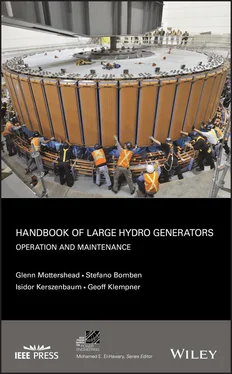3 Chapter 3Figure 3.1-1 Shows oil pot labyrinth seal at the top.Figure 3.1-2 Shows a typical high hat or chimney tube.Figure 3.2-1 Typical tube type surface air cooler.Figure 3.2-2 Shows typical water box on one side of surface air cooler.Figure 3.2-3 Cross section of a heat exchanger tube, showing the inner tube ...Figure 3.3-1 Thrust bearing cooling coil.Figure 3.3-2 Simple copper tubing used for cooling of the oil inside an oil ...Figure 3.4-1 Simplified Schematic of the pure water system piping.Figure 3.4-2 Relationship between conductivity and pH under ideal conditions...Figure 3.5-1 Shows pilot and main rotating exciters.Figure 3.5-2 Schematic of a shaft‐driven, rotating pilot and main excitation...Figure 3.5-3 Typical stator or stationary field.Figure 3.5-4 Typical rotating exciter armature.
4 Chapter 4Figure 4.1-1 Typical nameplate for a hydro generator.Figure 4.1-2 Schematic representation of a generator feeding a load through ...Figure 4.1-3 Typical capability curve for internal utility use.Figure 4.1-4 Typical saturation curve for transformers and generators.Figure 4.1-5 Hysteresis losses under normal and abnormal conditions.Figure 4.1-6 Manufacturer issued V /Hz curve.Figure 4.3-1 Open circuit and short circuit characteristics.Figure 4.3-2 Typical open circuit saturation characteristic.Figure 4.3-3 Typical short circuit characteristic.Figure 4.3-4 Typical capability curve from the manufacturer.Figure 4.3-5 Basic capability curve for internal utility use.Figure 4.3-6 Another manufacturer curve showing saliency circle and theoreti...Figure 4.3-7 Typical V‐curve from the manufacturer.Figure 4.5-1 Armature reaction.Figure 4.5-2 How the armature reaction affects the output voltage of a gener...Figure 4.5-3 Generator equivalent circuit.Figure 4.5-4 Vector representation of the fundamental circuit equation.Figure 4.5-5 Power transfer function applied to the power transferred betwee...Figure 4.5-6 Graphic representation of the fundamental circuit equation.Figure 4.5-7 Graphic solution for change of excitation from I F1to I F2.Figure 4.5-8 Numerical example for Case 4.3.Figure 4.5-9 Continuation of Case 4.3 numerical example.Figure 4.5-10 Graphical representation of change in power.Figure 4.5-11 Numerical example for Case 4.4.Figure 4.5-12 Calculation of circulating current between two generators conn...Figure 4.5-13 Out‐of‐step mechanical conceptualization.Figure 4.5-14 Power system stability case with two lines and two busses befo...Figure 4.5-15 Simple case of generator stability from the generator perspect...Figure 4.6-1 Sets of balanced and unbalanced three‐phase phasors. (a) Balanc...Figure 4.6-2 An unbalanced set of three‐phase phasors and its symmetrical co...Figure 4.6-3 Symmetrical sequence components.Figure 4.6-4 Generator subjected to a phase‐to‐phase short circuit on its te...Figure 4.7-1 Typical life endurance of a shaft under periodic torsional stra...
5 Chapter 5Figure 5.3-1 Polar graph of instantaneous temperature magnitude for all hose...Figure 5.3-2 One hose‐outlet sensor indicating plugging as temperature in re...Figure 5.5-1 Embedded core thermocouple on lamination. Note that this figure...Figure 5.5-2 V/Hz curve.Figure 5.5-3 Core accelerometer placed on back of core between keybar and co...Figure 5.5-4 Limits for vibrational displacements [4].Figure 5.5-5 Illustration of a slot RTD installed in separator pad and locat...Figure 5.5-6 Fiber‐optic stator endwinding vibration transducer.Figure 5.5-7 Loose circuit ring vibrating and the white powder produced agai...Figure 5.5-8 Shows typical location of the partial discharge couplers on the...Figure 5.5-9 The Iris Power PDA‐IV RPinstrument.Figure 5.5-10 Slot discharge from loss of the semiconducting coating or coro...Figure 5.5-11 Internal and slot discharges.Figure 5.5-12 Shows stator core and parasitic currents.Figure 5.5-13 Shows the electrical arc as bar is vibrating and contact is lo...Figure 5.5-14 Shows the various locations for surface discharges in the endw...Figure 5.5-15 Damage at the semiconducting/stress control interface just out...Figure 5.5-16 Endwinding discharges where conductive debris is extending the...Figure 5.6-1 Radio‐frequency monitoring.Figure 5.7-1 A simple schematic for PD coupler locations on the generator wi...Figure 5.7-2 Typical partial discharge coupler installation.Figure 5.8-1 Plan view of the SSC installation.Figure 5.8-2 Stator slot coupler end view.Figure 5.8-3 Installed stator slot coupler.Figure 5.9-1 Shows a flux probe installation in progress on the stator core....Figure 5.9-2 Software output for flux probe data collected.Figure 5.9-3 Polar representation of flux probe data collected showing short...Figure 5.9-3 Shaft grounding brush.Figure 5.9-4 Airgap system architecture.
6 Chapter 6Figure 6.1-1 Single‐function protective relay.Figure 6.1-2 Schweitzer Engineering Laboratories SEL 300G multifunction rela...Figure 6.1-3 Beckwith Electric Co. Inc. M‐3425A multifunction relay.Figure 6.1-4 Beckwith M‐3425A multifunction generator protection outline (ty...Figure 6.3-1 High impedance ground protection and grounding transformer.Figure 6.3-2 Subharmonic voltage injection scheme.Figure 6.3-3 Protection using two loss of excitation relays.Figure 6.3-4 Example of a voltage balance relay circuit.Figure 6.3-5 Example of a generator with one PT feeding its protection and e...Figure 6.3-6 Functional diagram of a generator zone breaker failure scheme....Figure 6.3-7 Approximate equivalent circuit.Figure 6.3-8 Generator percentage differential relay slope characteristic.
7 Chapter 7Figure 7.1-1 Shows the effects of a metallic object on the surface of a stat...Figure 7.1-2 Foreign material caused serious core damage.Figure 7.2-1 Ground leads applied to the generator bus at the switchgear.Figure 7.5-1 Example set of inspection tools.Figure 7.5-2 Typical borescope with articulating head.Figure 7.5-3 Pocket knife used to spot check core tightness.
8 Chapter 8Figure 8.1-1 Shows bare soleplate on concrete foundation before encasing in ...Figure 8.1-2 Typical soleplate arrangement as seen under the stator frame.Figure 8.1-3 Shows solid rectangular key with grease fitting for lubrication...Figure 8.1-4 Shows original soleplate arrangement – Teflon ™pucks not ...Figure 8.1-5 Shows soleplate with Teflon ™puck inserts in a steel hous...Figure 8.1-6 Shows mating steel surfaces on stator frame.Figure 8.1-7 Shows completed soleplate arrangement from inside stator frame ...Figure 8.1-8 Shows outer blocks welded to the frame ring.Figure 8.1-9 Shows center block which aids radial freedom and prevents tange...Figure 8.1-10 Shows welded/integral soleplate.Figure 8.1-11 Showing soleplate nut and stator hold‐down bolt.Figure 8.1-12 Shows hold-down bolt individual components.Figure 8.1-13 Shows assembled hold down bolt without the stator in place.Figure 8.1-14 Shows soleplate arrangement that does not allow radial expansi...Figure 8.1-15 Shows removable dowel pins similar to the ones in Figure 8.1-1...Figure 8.1-16 Shows grout pocket cracking.Figure 8.1-17 Shows foundation cracking.Figure 8.2-1 Shows frame welds.Figure 8.2-1 Shows stator frame‐split complete with a dowel and bolted arran...Figure 8.2-3 Shows metal filings in a new generator.Figure 8.2-4 Shows a light coating of contamination on the shelves and core ...Figure 8.2-5 Shows a significant amount of oil from a bearing leak.Figure 8.3-1 Shows that the core flares a small amount around the I‐beam ass...Figure 8.3-2 Shows core is more uniform and does not droop around the I‐beam...Figure 8.3-3 Shows stator core air ducts choking off airflow.Figure 8.4-1 Shows laminar fretting and missing pieces of stator core on the...Figure 8.4-2 Shows laminations found at bottom of generator pit.Figure 8.4-3 Shows piece of lamination on rotor pole.Figure 8.4-4 Shows degradation of the stator laminations, core finger, and w...Figure 8.4-5 Shows excellent core‐to‐keybar interface with no broken laminat...Figure 8.4-6 Shows fretting and broken and missing lamination pieces.Figure 8.4-7 Shows lamination shift at the very top of the core under clampi...Figure 8.4-8 Shows knife penetration of laminations.Figure 8.4-9 Core‐to‐keybar fretting – subtle beginning.Figure 8.4-10 Shows split axial misalignment.Figure 8.4-11 Shows minor smearing after repairs.Figure 8.4-12 Shows split paper still in place.Figure 8.4-13 Shows split fretting (red‐orange dust).Figure 8.4-14 Shows split that has been repacked by the OEM.Figure 8.4-15 Shows chevroning of the core.Figure 8.4-16 Shows stator core step punching fretting.Figure 8.4-17 Shows weeping epoxy (red color) on the laminations to consolid...Figure 8.4-18 Shows severe stator core step punching fretting and subsequent...Figure 8.4-19 Shows clamping plate removed exposing the finger assembly.Figure 8.4-20 Shows the fingers/heavy lamination and clamping plate assembly...Figure 8.4-21 Shows welded fingers to the clamping plate.Figure 8.4-22 Shows a gap between the clamping finger and stator core lamina...Figure 8.4-23 Shows insulating repair wedge epoxied in place (red color is e...Figure 8.5-1 Shows a typical clamping plate and finger assembly.Figure 8.5-2 Shows clamping fingers welded to the heavy lamination.Figure 8.5-3 Shows assembled clamping plate and the fingers with heavy lamin...Figure 8.5-4 Shows two fingers into the airgap and one finger machining the ...Figure 8.5-5 Shows crooked clamping finger.Figure 8.5-6 Shows bare stator frame before piling of core with keybars and ...Figure 8.5-7 Shows insulated core clamping studs that go through the core as...Figure 8.5-8 Shows the core stud and keybar attachment to the frame.Figure 8.5-9 Shows the core keybar/stud attachment to the frame.Figure 8.5-10 Shows keybar support gusset weld crack.Figure 8.5-11 Shows the gusset cracked as well as the weld.Figure 8.5-12 Shows another example of weld cracking.Figure 8.6-1 Shows chunks of insulation missing.Figure 8.6-2 Shows tape separation as evidenced by the black area on the end...Figure 8.6-3 Shows girth cracking (necking) evidenced by the separation of g...Figure 8.6-4 Shows partial discharge (white powder) at the interface.Figure 8.6-5 Shows extreme deterioration of the semi‐con/grading interface....Figure 8.7-1 Shows bypassed stator bar.Figure 8.7-2 Shows resistor on bottom end of winding into bypassed bar.Figure 8.8-1 Shows normal wedge installation.Figure 8.8-2 Shows filler migration.Figure 8.8-3 Shows center filler migrating out the bottom of the winding.Figure 8.8-4 Shows the black packing strip (at bottom of slot) migrating out...Figure 8.8-5 Shows felt and lashing added to prevent wedge and filler migrat...Figure 8.8-6 Shows wedge fretting and evidence of greasing on core packet.Figure 8.8-7 Shows silicone applied to the endwinding with insufficient clea...Figure 8.8-8 Shows bull ring and bull ring support.Figure 8.8-9 Circuit rings sitting inside the red blocking and lashed.Figure 8.8-10 Shows another style of circuit ring arrangement.Figure 8.8-11 Shows a completed brazed connection.Figure 8.8-12 Shows completed taped and epoxy encapsulated brazed connection...Figure 8.8-13 Shows encapsulation or end caps for a bar winding.Figure 8.8-14 Shows jumper connections encapsulated.Figure 8.8-15 Shows open type series connection.Figure 8.8-16 Shows rivet fastener on copper clip.Figure 8.10-1 Shows a more modern encapsulated type of current transformer....Figure 8.10-2 Shows older style taped CT.
Читать дальше











